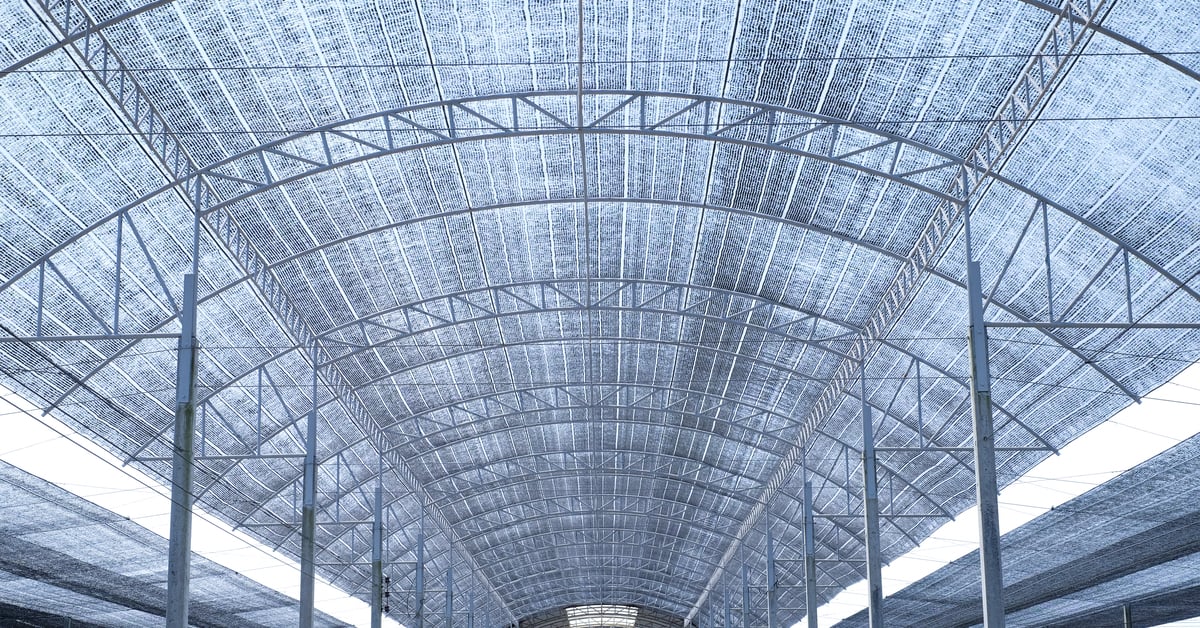
Greenhouses naturally trap heat. As such, you’ll need to find an effective way to cool it down. One popular method of cooling down greenhouses is with shade cloths. Shade cloths are also sometimes called energy curtains, shades, thermal curtains, screens, heat retention curtains or blankets and are designed for greenhouses to hold a controlled temperature by creating shade or retaining heat.
The curtains should be used when the energy consumption is high, the radiation from the sun is too intense or the humidity is too low. Shade cloths design consists of moveable panels made from fabric or a plastic film that is used to shield the space enclosed in the greenhouse. They can be even be automated depending on the setup with the use of climate data.
What are shade cloths made from?
Shade cloths are typically made from materials such as knitted white polyester, non-woven bonded white polyester fibre and composite fabric. In recent years, white polyester has replaced composite fabric as the popular option because it offers a high quality of durability due to its combination of alternating strips of clear aluminized polyester or acrylic finely mesh of threads.
Blackout curtains can be used to reduce the build-up of heat by covering the greenhouse for day length control during summer. They are broken down into three materials: polyethene film, knitted polyester and composite fabric where all the strips are either aluminized or opaque.
Shade cloth cooling tips for greenhouses
When selecting a shade cloth, choosing a tighter or looser weave will significantly impact your greenhouse. A looser weave will help address excessive humidity, while a tighter weave will help trap the humidity and temperature inside.
Radiant cooling can be used to prevent a drop in temperature overnight and reduce stress in plants in colder climates. When cool air is trapped between the curtain and the roof of the greenhouse, it can be released slowly in the morning to mix with the warmer air below. This should be done in stages, so you don’t stress the plants from a sudden change in temperature.
Ensure you control the exposure level of solar energy to plants and utilize shade screens to protect the tips of leafy greens from burning. You’ll also want to keep an eye on moisture levels and overall greenhouse temperature.
There are three ways shade cloths can be utilized in your greenhouse: sidewall curtains, gutter-to-gutter systems and truss-to-truss systems.
Option 1: Sidewall Curtains
To maximize natural ventilation inside the greenhouse, using sidewall curtains will help the heat escape as fresh air enters the structure. There are three options to choose from when deciding how you will raise and lower side wall curtains:
(1) The curtain material wraps around a tube, so the curtain wall can be raised or lowered by either a hand crank or electric motor box.
(2) Attach ropes and pulleys at the top edge on the side wall curtain to drop the shade open or lift it closed.
(3) Use a tube to roll and unroll the material. Rotate the tube by cradling it in rope loops that run through pulleys, back to a hand crank or to a block that travels up and down a motorized lead-screw.
Option 2: Gutter-to-Gutter System
The gutter system is used to minimize the volume of the air in the greenhouse. The curtains are pulled flat across the width of the greenhouse at gutter height. Note that gutter systems are not suitable for all greenhouses. One disadvantage of the gutter-to-gutter system is that circulation fans mounted at the gutter level will be closed off by the curtain, blocking the heat or air circulation under the system where the crop is. Also, if existing gas lines, electrical conduits and heating pipes are fitted at gutter level, this can be problematic for the curtains and will be required to move. There is also no room to hang baskets in the greenhouse because the baskets will get in the way of the curtain.
However, the gutter system is beneficial in that there are less heating costs per ground area and the labor required for installation is easier than a truss-to-truss system.
Option 3: Truss-to-Truss System
The third option is panels of curtains constructed from material designed to move across one truss to another.
There are three ways to configure the truss-to-truss system:
1. Flat at gutter height
Setting up your truss-to-truss system flat at gutter height is similar to the gutter system. It benefits the greenhouse by minimizing the volume of the space to be heated and has a smooth installation process.
2. Slope-flat-slope
The slope-flat-slope option is when the profile of the curtain follows each slope of the roof, partway up the truss, concluding with the flat section joining the two sloped segments. This method has two benefits:
• Installation of the system can fit over the equipment, mounted above the gutter
• Remaining space left over to hang baskets in your greenhouse
3. Slope-slope
The slope-slope system is where the profile draws parallel lines from the gutter to the peak of the truss. This technique minimizes the amount of cold air trapped above the curtain and maximizes the clearance from equipment mounted above the gutter. Both slope-flat-slope and slope-slope have the same drawbacks. These are:
-
Because they are higher off the floor, more time is consumed to install
-
The systems leave more greenhouse volume in comparison to the flat system
-
The structure requires more materials for moving and stationary edges than the flat system which covers the same amount of growing area
However, like the slope-flat-slope, there is remaining space left over to hang baskets in your greenhouse.
Cooling your greenhouse with thermal shade cloths can be a cost-effective method of regulating temperature for a successful crop yield.
Contact Autogrow today to discuss the best options for your grow environment.



.png?height=100&name=Meet%20the%20team%20%20(4).png)
Submit a comment